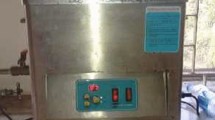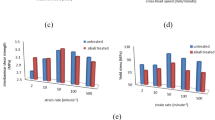Abstract
Natural fibre-reinforced composites are being widely employed in many fields. These composites are preferred for their specific properties and eco-friendly nature. Natural fibres do not bond well with resin readily. Alkali treatment of these fibres has been reported to be effective in achieving better bonding. Addition of nanofillers has been reported to enhance the performance of composites. The current work investigates the machinability of jute fibre-reinforced nanophased polymer composite. Machinability is expressed in terms of delamination factor, which has been obtained using image processing technique. The influence of matrix, fibre surface modification and nanofiller on delamination is reported. Machining was done using high-speed steel tool. ANOVA has been performed to identify the parameter that significantly influences the delamination factor. Fibre surface modification and graphene as nanofiller have improved the machinability.
Similar content being viewed by others
References
Wambua P.: Natural fibres: Can they replace glass in fibre reinforced plastics?. Compos. Sci. Technol. 63, 1259–1264 (2003)
Hossain M.K.: Mechanical performances of surface modified jute fiber reinforced biopol nanophased green composites. Compos. B 42, 1701–1707 (2011)
Shah D.U.: Developing plant fibre composites for structural applications by optimising composite parameters: a critical review. J. Mater. Sci. 48, 6083–6107 (2013)
Thakur V.K.: Silane functionalization of Saccaharum cilliare fibers: thermal, morphological, and physicochemical study. Pol. Anal. Charac. 15(7), 397–414 (2010)
Dweib M.A.: All natural composite sandwich beams for structural applications. Compos. Struct. 63, 147–157 (2004)
Ramesh M.: Mechanical property evaluation of sisal–jute–glass fiber reinforced polyester composites. Compos. B 48, 1–9 (2013)
Koronis G.: Green composites: a review of adequate materials for automotive applications. Compos. B 44, 120–127 (2013)
Avella M.: Eco-challenges of bio based polymer composites. Materials 2, 911–925 (2009)
Atluri R.P.V.: Experimental investigation of mechanical properties of golden cane fiber-reinforced polyester composites. Pol. Anal. Charac. 18(1), 30–39 (2013)
Kabir M.M.: Chemical treatments on plant-based natural fibre reinforced polymer composites: an overview. Compos. B 43, 2883–2892 (2012)
Narendar R.: Effect of chemical treatment on the mechanical and water absorption properties of coir pith-nylon-epoxy sandwich composites. Pol. Anal. Charac. 18(5), 369–376 (2013)
Albuquerque A.C.: Effect of wettability and ageing conditions on the physical and mechanical properties of uniaxially oriented jute-roving-reinforced polyester composites. Compos. Sci. Technol. 60, 833–844 (2000)
Morsyleide Rosa F.: Effect of fiber treatments on tensile and thermal properties of starch/ethylene vinyl alcohol copolymers/coir biocomposites. Biores. Technol. 100, 5196–5202 (2009)
Mohanty A.K.: Surface modification of jute and its influence on performance of biodegradable jute fabric/biopol composites. Compos. Sci. Technol. 60, 1115–1124 (2000)
Kuilla T.: Recent advances in graphene based polymer composites. Prog. Poly. Sci. 35, 1350–1375 (2010)
Potts J.: Graphene-based polymer nano composites. Polymer 52, 5–25 (2011)
Dehghan M.: Effect of fabrication method on thermo-mechanical properties of an epoxy composite. Adhesion 90, 368–383 (2014)
Liu D.: A review of mechanical drilling for composite laminates. Compos. Struct. 94, 1265–1279 (2012)
Abrao A.M.: Drilling of fiber reinforced plastics: a review. Mater. Proc. Technol. 186, 1–7 (2007)
Hocheng H.: Effects of special drill bits on drilling-induced delamination of composite materials. Mach. Tools Manuf. 46(11), 1403–1416 (2006)
Tsao C.C.: Thrust force and delamination of core-saw drill during drilling of carbon fiber reinforced plastics (CFRP). Adv. Manuf. Technol. 37, 23–28 (2008)
Rajamurugan T.V.: Analysis of delamination in drilling glass fiber reinforced polyester composites. Mater. Design 45, 80–87 (2013)
Jain S.: Delamination free drilling of composite laminates. Eng. Ind. Trans. ASME 116(4), 475–481 (1994)
Gao S.L.: Scanning acoustic microscopy as a tool for quantitative characterization of damage in CFRP’s. Compos. Sci. Technol. 54, 345–354 (1999)
Davim P.: A novel approach based on digital image analysis to evaluate the delamination factor after drilling composite laminates. Compos. Sci. Technol. 67, 1939–1945 (2007)
Sridharan V.: Optimization of machinability of polyester/modified jute fabric composite using grey relational analysis (GRA). Proc. Eng. 64, 1003–1012 (2013)
Ponnuvel S.: Investigation on the influence of multi walled carbon nanotubes on delamination in drilling epoxy/glass fabric polymeric nano composite. Proc. Eng. 51, 735–744 (2013)
Tsao C.C.: Taguchi analysis of delamination associated with various drill bits in drilling of composite material. Mach. Tools Manuf. 44, 1085–1090 (2004)
Hocheng H.: The path towards delamination-free drilling of composite materials. Mater. Proc. Technol. 167, 251–264 (2005)
Kaddami H.: Short palm tree fibers—thermoset matrices composites. Compos. A 37(9), 1413–1422 (2006)
Tang L.-C.: The effect of graphene dispersion on the mechanical properties of graphene/epoxy composites. Carbon 60, 16–27 (2013)
Prolongo S.G.: Advantages and disadvantages of the addition of graphene nanoplatelets to epoxy resins. Euro. Poly. 61, 206–214 (2014)
Ross P.: Taguchi Techniques for Quality Engineering. Tata McGraw-Hill Publishing, New Delhi (2005)
Author information
Authors and Affiliations
Corresponding author
Rights and permissions
About this article
Cite this article
Sridharan, V., Raja, T. & Muthukrishnan, N. Study of the Effect of Matrix, Fibre Treatment and Graphene on Delamination by Drilling Jute/Epoxy Nanohybrid Composite. Arab J Sci Eng 41, 1883–1894 (2016). https://doi.org/10.1007/s13369-015-2005-2
Received:
Accepted:
Published:
Issue Date:
DOI: https://doi.org/10.1007/s13369-015-2005-2




